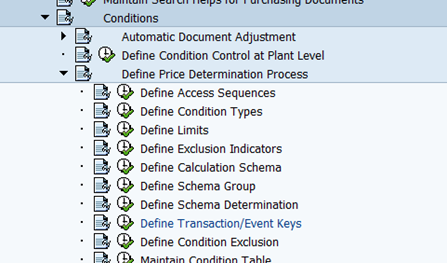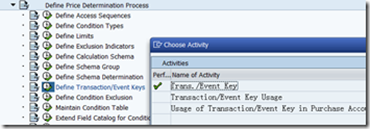定义Transaction/Event keys
其实Tran./Event Key这个东东只是一个代码,主要是用来通过OBYC和科目关联
定义Transaction/Event keys
只要定义一个Tran./Event Key,之后OBYC画面就可以看到了。
Transaction Key
updated Nov 28, 2009 4:55 am | 8,400 views
Transaction Key
In SAP the subject topic is refered to as point of integration between different moudles such as SD, MM & FI. Before starting this, it is always advisable to recap the things which are related to integrations of MM to FI, specifically, the areas related to inventory management and invoice verification. Only if you are comfortable with this integration and well versed in automatic postings then only you will be able to recognize the significance of a transaction key. In SAP, these are also known as "event keys" or "internal processing keys." These are predefined number of transactions relevant to inventory management and invoice verification. Inventory management assigns these to different movement types and invoice verification assigns to each relevant transaction. Extracted from standard SAP as follows:
IMPORTANT TRANSACTION KEYS USED IN INVENTORY MANAGEMENT & LOGISTIC INVOICE VERIFICATION .
AUM - Stock transfers are there between plants and from one movement type to another with split valuation. The difference between the price at the delivering plant and the receiving point is booked at the later. BO1 - Subsequent settlement of Provisions (eg: volume based rebate) BO2 - Subsequent settlement of revenues -conditions in invoice verification BO3 - Provision Differences BSV - The Company send materials for subcontract work, this transaction is considered. BSX - All stock postings to Stock Accounts due to Goods receipts & goods issues in Inventory Management. DIF - Small Differences that may arise during invoice verification in the invoice amount not exceeding tolerance. FR1 - Freight Clearing FR2 - Provisions for freight Charges FR3 - Customs Clearing FR4 - Provisions for Customs Clearing FRL - Services are performed for the company externally. FRN - Services are performed for the company externally and hence delivery costs GBB - Offsetting Entries for Inventory Postings KBS - Account - assigned Purchase Order KDR - Exchange rate rounding differences in case of foreign currency invoices KDM - Exchange rate rounding differences for open items (invoice posting with a different exch. rate than the GR/due to Std price difference/insufficient stock coverage) KON - Consignment payables KTR - Offsetting entry for price differences in cost object hierarchies PRD - Price Differences PRK - Price Differences in cost object hierarchies VST - INPUT TAX WRX - GR/IR clearing account
If a MM consultant thinks that these predefined Keys will be sufficient to meet the client requirement then he does not have to define them. In this case, the only thing he has to do is to assign the relevant G/L account to each posting transaction key. Once this setting is done than SAP will take care of rest automatically.
In most of the cases, due to complexity of business processes at the client level, consultants find that the use of these transaction/event keys supplied with the standard system is insufficient. They are bound to create more transaction keys to meet the client’s specific requirements. Normally, these requirements come to capture the different types of freight costs either accrual or provisioned. In addition, capturing of different types of planned and unplanned delivery costs in different G/L accounts has now become commonplace. If this is the requirement, a MM consultant should take the following configuration settings in SAP.
1. Create new Transaction Key either with the letter Z or the digit 9 (Making it is available in T. )
2. Code OBYC (configure automatic posting) assign appropriate G/L Account like other Transaction Keys.
3. Assign it to one or more condition types in the relevant Pricing Procedure under appropriate column (AccKY or Provis)
from ToolBox







